Hearthstone: Blackrock Mountain Review
Hearthstone: Blackrock Mountain
Review Diary Week 5: We take on Nefarius with our honed card deck
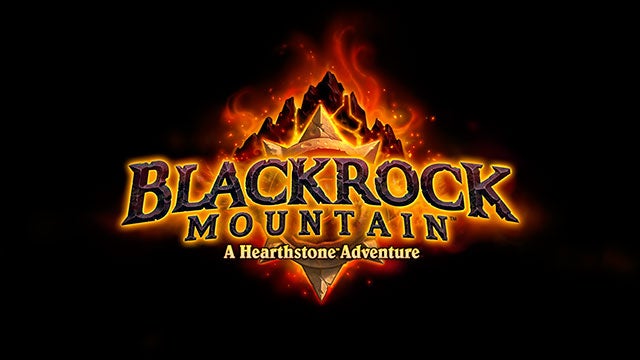
Verdict
Pros
- Challenging bosses
- New and interesting cards
- Impetus to deck-build
Cons
- Heroic difficulty is still eye-wateringly hard
- You have to wait to play it all even if you pre-ordered
Key Specifications
- Review Price: £17.49
Hearthstone Blackrock Mountain review diary – Week 5
Available on Android and iPad
So here it is at last: the final level of Hearthstone’s latest Solo Adventure and we can’t help but say we’re a little disappointed. It’s not that The Hidden Laboratory level isn’t fun. It’s not that it doesn’t inspire repeated play-throughs. It’s just that after the nightmare that was Blackwing Lair, we were expecting a little more of a challenge. As it happened, we were able to waltz through the last level of Blackrock Mountain in a manner that felt just a little bit too easy.
Well, not entirely. The first Boss, Omnotron, took more than a few attempts to beat. This is because its special power – Activate Arcanotron – summons a Mech and that minion’s attack and health scores reflect the manna cost the AI has to pour into them. At low levels, Omnotron can pull out minions that give the player (and itself) extra spell damage or units that deal one point of damage to every minion on the board. At high levels, it unleashes a minion that deals a point of damage to any player (AI included) that casts a spell or summons a minion.
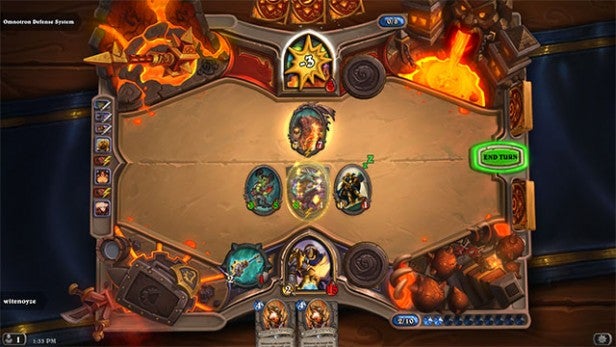
On top of that, Omnotron’s deck is stacked to the rafters with Mechs that have annoying special abilities, such as the Iron Sensei, which boosts other Mechs’ health and attack the longer it’s left in play. There’s also its unique Recharge card to watch out for, which essentially fills its manna pool right to the top for very little cost. Believe us when we tell you, once both players’ manna pools contain more than six gems, you don’t want to see this card activated – and that’s usually when it is.
So the Omnotron is a sod, basically, and that’s probably why it’s the only Boss available in Challenge Mode. Thankfully, however, players are controlling a Paladin that has a ton of nasty booster cards and shedload of dragons. Many of the cards in the player’s hand either reduce the amount of manna required to bring subsequent minions into play, or offer some sort of boost, given the number of spells they cast on them. It’s not a cakewalk by any means but it does level the playing field somewhat. It’s also heaps of fun to play through.
If only the same could be said of the four remaining Bosses in The Secret Laboratory. First up, players have Maloriak to contend with. His special ability swaps the health and attack of minions that are summoned. This may sound irritating, until you consider the fact that low cost minions and boosts are all you need to beat him. Toss in some cards that cause massive splash damage and you’re looking at a fight that you can win relatively easily – since Maloriak’s power harms his own troops as much as the player’s.
See also: Best iPad Games 2015
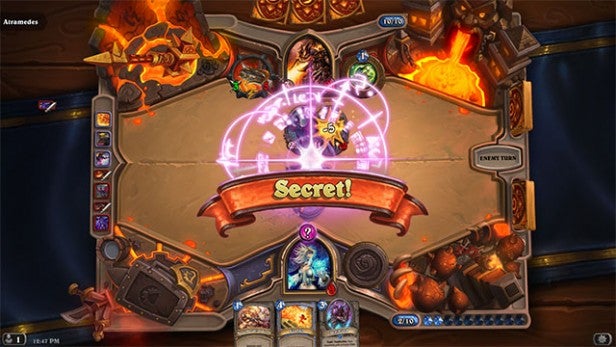
Next up is the blind dragon Altramedes, whose special ability allows him to equip a weapon that gains one point of damage each time the player plays a card. However, to balance things out, players have three cards in their hand at the start of the match that destroy Altramedes’ weapon for the low cost of one manna point. If you have a couple of minions in your deck that have the ability to destroy an enemy’s ordinance as a Battle-Cry you should be able to blaze through this battle relatively easily – especially if you augment your minions with low-cost Taunts.
Which brings us to the final Boss, Nefarian (yes, again!), whom players have to tackle without the help of his former employer, Ragnaros. In this instance, however, the battle is less intimidating; instead of 30 armour and the ability to copy the player’s cards, Nefarian now has 10 armour and he summons a couple of low-level minions every other round. Once again, the deck the AI will pose the player a few problems. But those battle-hardened souls who have blazed a trail through the online Play and Arena modes won’t really need to engage in too much deck-building to quash Blackrock Mountain’s final Boss… at least on Normal Difficulty.
We’re currently battling through Heroic Difficulty and we expect to be for some time. Say whatever else you like about Blizzard – when they create a level and call it ‘Heroic’, they mean it!

Hearthstone: Blackrock Mountain review diary – Week 4
As players venture deeper into Blackrock Mountain, they’ll notice the heat gets turned way up. The four bosses lurking down in the penultimate level of Hearthstone’s new single-player adventure are a hard bunch to beat. You will need to stack a deck for each of them as their special abilities and the cards they play make them all eye-wateringly difficult.
Razorgore The Untamed takes a bit of getting used to. His main power serves to distract the player from using their minions directly against him. Razorgore starts every match with a Corrupted Egg on the board and every turn, for the cost of one measly manna point, he gives any eggs in play an extra point of health and summons another one. Once the egg reaches four points of health, it hatches, tossing a Chromatic Drake (that’s a 7/3 dragon minion to you) into play. On Heroic Mode, incidentally, those Drakes are hatched with 7 for attack and 7 for health, so keeping the flow of eggs staunched is rather necessary.

So the player is faced with having to decide on each turn whether they’re going to destroy the never-ending production line of eggs, or deal damage to Razorgore, a choice made all the more difficult by the cards the AI flings out at the player. Most of them are low cost minions that deal annoying amounts of damage; many receive a boost in attack and health or have a damaging Battle Cry if Razorgore has a dragon in his hand – and he always has a dragon in his hand.
This boss, funnily enough, is something of a cakewalk in Challenge Mode, in which the player finds themselves up against Razogore with a Warlock deck stacked to the hilt with Demons. Aside from punishing specimens such as Floating Watchers and Void Terrors, there are a couple of Legendary cards in the stack, such as Mal’Ganis (who gives every other Demon in play a boost and makes the player immune from damage) and Lord Jaraxxus (who acts as last-gasp safety net and summons Infernal minions with 6 Attack and 6 Health). Toss in cards like Demonwrath (which splash damages non-demons) and Booster cards like Demonheart and you’re looking at a pretty hefty set of options. Having played through this battle several times, we found it impossible to lose.

Up next is Vaelastrasz, a corrupted Dragon who has the annoying ability to force the player to draw two cards every turn for no manna cost at all. While this sounds useful, in practice what it means is that if the player has a deck of high-cost/high-damage minion cards, they’re likely to find themselves holding several of them before they have the manna to bring them into play. Furthermore, players will find themselves running out of cards very quickly – unless they have a card like Gang-Up, which they can use to refill their deck, like Vaelastrasz does.
On top of that, Vaelastrasz’s deck is geared towards burning the player’s minions and filling up their hand as quickly as possible. The reasons for this are, firstly, to cause the player Card Fatigue, and secondly, because most of the minions in Vaelastrasz’s deck gain some sort of bonus (attack, life or summon cost) the more cards the player has in their hand. Oh, and then there’s the small matter that Vaelastrasz has a unique card called Burning Adrenaline, which causes the player’s hero two points of damage at the cost of no manna.
The Challenge mode for this Boss gives players a couple of hints on how to tackle it (and that’s probably why you have to complete the entire level to unlock it). Players are pitted against Vaelastrasz with a Rogue deck teeming with low cost spells, the odd minion and prep cards that allow them to lower the cost of some spells to zero. Because of this, the AI isn’t as readily able to fill up the player’s hands as quickly as before. On heroic difficulty, things become rather silly as Vaelastrasz starts the game with an extra 15 points of armour on top of his health points and his special ability earns him a manna point and forces the player to draw two extra cards every round instead of two.
As bad as all that sounds, however, it pales into insignificance next to the third boss – Chromaggus – who shuffles a Brood Affliction card into the player’s hand at the end of every turn. While they sit in there, they confer the AI certain advantages – minions cost less, the players takes one point of damage every round or Chromaggus heals up at the end of his turn are just some examples. In order to get rid of them, players need to spend a manna point. The more cards sit in their hand, the more manna they need to burn to level the playing field. On top of that, Chromaggus has a couple of minions in his deck that power up significantly every time the player casts a spell card – and burning a Brood Affliction card counts as casting a spell. On Heroic level, Chromaggus starts off with 60 Health points and 15 armour points and burning a Brood Affliction card costs three manna rather than one.

Lord Victor Nefarius – the final boss in Blackwing Lair – is the real wild card of the bunch. As the battle starts, he transforms into a dragon with 30 points of armour on top of his 30 points of health and his manna pools fills right up to ten crystals. His special ability allows him to copy a random card from whatever class the player is using into his deck.
Sounds insurmountable, yes? Well, it probably would be, if Ragnaros – the boss from two tiers ago – didn’t get involved and start throwing zero-cost spells and minions into the player’s hand every turn. Even with the Fire Lord’s help, Nefarius is still a steep mountain to climb – steeper still in Heroic mode when he arrives with 50 armour and you get no help whatsoever from Ragnaros.
If you can manage that duel, you’re a better player than us. So far, we’ve only managed to last a handful of rounds before being diced. Still, you live and you learn…

Hearthstone: Blackrock Mountain review diary – Week 3
As players venture deeper into Blackrock Mountain, they’ll notice the heat gets turned way up. The four bosses lurking down in the penultimate level of Hearthstone’s new single-player adventure are a hard bunch to beat. You will need to stack a deck for each of them as their special abilities and the cards they play make them all eye-wateringly difficult.
Razorgore: The Untamed takes a bit of getting used to. His main power serves to distract the player from using their minions directly against him. Razorgore starts every match with a Corrupted Egg on the board and every turn, for the cost of one measly manna point, he gives any eggs in play an extra point of health and summons another one. Once the egg reaches four points of health, it hatches, tossing a Chromatic Drake (that’s a 7/3 dragon minion to you) into play. On Heroic Mode, incidentally, those Drakes are hatched with 7 for attack and 7 for health, so keeping the flow of eggs staunched is rather necessary.

So the player is faced with having to decide on each turn whether they’re going to destroy the never-ending production line of eggs, or deal damage to Razorgore, a choice made all the more difficult by the cards the AI flings out at the player. Most of them are low cost minions that deal annoying amounts of damage; many receive a boost in attack and health or have a damaging Battle Cry if Razorgore has a dragon in his hand – and he always has a dragon in his hand.
This boss, funnily enough, is something of a cakewalk in Challenge Mode, in which the player finds themselves up against Razogore with a Warlock deck stacked to the hilt with Demons. Aside from punishing specimens such as Floating Watchers and Void Terrors, there are a couple of Legendary cards in the stack, such as Mal’Ganis (who gives every other Demon in play a boost and makes the player immune from damage) and Lord Jaraxxus (who acts as last-gasp safety net and summons Infernal minions with 6 Attack and 6 Health). Toss in cards like Demonwrath (which splash damages non-demons) and Booster cards like Demonheart and you’re looking at a pretty hefty set of options. Having played through this battle several times, we found it impossible to lose.
See also: Best iPad Games
Up next is Vaelastrasz, a corrupted Dragon who has the annoying ability to force the player to draw two cards every turn for no manna cost at all. While this sounds useful, in practice what it means is that if the player has a deck of high-cost/high-damage minion cards, they’re likely to find themselves holding several of them before they have the manna to bring them into play. Furthermore, players will find themselves running out of cards very quickly – unless they have a card like Gang-Up, which they can use to refill their deck, like Vaelastrasz does.
On top of that, Vaelastrasz’s deck is geared towards burning the player’s minions and filling up their hand as quickly as possible. The reasons for this are, firstly, to cause the player Card Fatigue, and secondly, because most of the minions in Vaelastrasz’s deck gain some sort of bonus (attack, life or summon cost) the more cards the player has in their hand. Oh, and then there’s the small matter that Vaelastrasz has a unique card called Burning Adrenaline, which causes the player’s hero two points of damage at the cost of no manna.
The Challenge mode for this Boss gives players a couple of hints on how to tackle it (and that’s probably why you have to complete the entire level to unlock it). Players are pitted against Vaelastrasz with a Rogue deck teeming with low cost spells, the odd minion and prep cards that allow them to lower the cost of some spells to zero. Because of this, the AI isn’t as readily able to fill up the player’s hands as quickly as before. On heroic difficulty, things become rather silly as Vaelastrasz starts the game with an extra 15 points of armour on top of his health points and his special ability earns him a manna point and forces the player to draw two extra cards every round instead of two.
 As bad as all that sounds, however, it pales into insignificance next to the third boss – Chromaggus – who shuffles a Brood Affliction card into the player’s hand at the end of every turn. While they sit in there, they confer the AI certain advantages – minions cost less, the players takes one point of damage every round or Chromaggus heals up at the end of his turn are just some examples. In order to get rid of them, players need to spend a manna point. The more cards sit in their hand, the more manna they need to burn to level the playing field. On top of that, Chromaggus has a couple of minions in his deck that power up significantly every time the player casts a spell card – and burning a Brood Affliction card counts as casting a spell. On Heroic level, Chromaggus starts off with 60 Health points and 15 armour points and burning a Brood Affliction card costs three manna rather than one.
As bad as all that sounds, however, it pales into insignificance next to the third boss – Chromaggus – who shuffles a Brood Affliction card into the player’s hand at the end of every turn. While they sit in there, they confer the AI certain advantages – minions cost less, the players takes one point of damage every round or Chromaggus heals up at the end of his turn are just some examples. In order to get rid of them, players need to spend a manna point. The more cards sit in their hand, the more manna they need to burn to level the playing field. On top of that, Chromaggus has a couple of minions in his deck that power up significantly every time the player casts a spell card – and burning a Brood Affliction card counts as casting a spell. On Heroic level, Chromaggus starts off with 60 Health points and 15 armour points and burning a Brood Affliction card costs three manna rather than one.
Lord Victor Nefarius – the final boss in Blackwing Lair – is the real wild card of the bunch. As the battle starts, he transforms into a dragon with 30 points of armour on top of his 30 points of health and his manna pools fills right up to ten crystals. His special ability allows him to copy a random card from whatever class the player is using into his deck.
Verdict
Sounds insurmountable, yes? Well, it probably would be, if Ragnaros – the boss from two tiers ago – didn’t get involved and start throwing zero-cost spells and minions into the player’s hand every turn. Even with the Fire Lord’s help, Nefarius is still a steep mountain to climb – steeper still in Heroic mode when he arrives with 50 armour and you get no help whatsoever from Ragnaros.
If you can manage that duel, you’re a better player than us. So far, we’ve only managed to last a handful of rounds before being diced. Still, you live and you learn…
 Blackrock Spire is now open and if you’ve managed to blaze through the new expansion for Blizzard’s virtual card trading game with little trouble up until now, buckle up. This is where it gets bumpy. The three bosses in Blackrock Mountain’s third tier are troublesome to say the least.
Blackrock Spire is now open and if you’ve managed to blaze through the new expansion for Blizzard’s virtual card trading game with little trouble up until now, buckle up. This is where it gets bumpy. The three bosses in Blackrock Mountain’s third tier are troublesome to say the least.
The first among them, Highlord Omokk is an ogre with a deck stacked with Warrior Class cards and… er… well, ogres – nasty ones, such as Ogre Ninjas (6/6 + Stealth). He also has the rather annoying special ability to destroy any minions you have on the field who have been injured – and he usually aims for the damaged minion with the highest attack value every single time he activates this power. So, a lot of Warrior Class cards that deal damage to a minion in exchange for a raised attack are only good for one round.

The AI’s strategy essentially involves wiping high-attack-value and Taunt minions quickly – at the cost of one manna – and charging past any minions who don’t have Taunt and dealing as much damage to your character as possible. Healing cards are useful, although they’ll get you so far and no further. The key here is to build a deck with expendable (read: cheap) Taunt cards and enough power ups to deliver the optimum amount of damage per hand. There’s no set way forward here – just as there isn’t with the rest of the bosses – and luck does play a part.
The second boss, General Drakkisath, changes up the framework of how players are used to tackling matches in Hearthstone. His power is in effect for the entire match and costs him no manna. What it does is limit the player’s manna pool to one stone per turn, but reduces the cost of every card in their hand to one manna. The best way to progress through this boss battle is to stack your hand with as many high-cost high-damage dealing cards as possible and pray that the Gods are favourable. General Drakkisath’s match is a turn-based slug-fest involving some of the most powerful cards in the game. It’s almost like playing Hearthstone the same way you’d play a game of Snap; this, rubric, by the way, becomes steroid-injected in the challenge mode where the player’s hand consists of nothing but Legendary Cards.
See also: iPad Air 2 vs iPad Air
The third boss, Rend Blackhand, is where the going gets tough and the tough hide under the table. This is because he has three hero powers and they change on a dime. The first summons three 1/1 minions. The second summons two 1/1 minions with a taunt. The third summons a Glyph (8/4). And then there’s the fact that the AI can change up Blackhand’s special power, like it’s some sort of chocolate box from hell.
Splash damage cards are just half the battle in this exchange; players need to stack their deck with Taunt and Power-Up cards in order to get some inches on the playing field. In the challenge mode, the pre-loaded deck helps somewhat, stacking Echoing Ooze cards with Defender of Argus cards (save these for a few rounds and you’ll have a set of annoying Taunt minions) with cards that lower in cost the more minions you lose – and you’ll lose a lot.
Verdict
Blackrock Spire, then, is a tougher challenge than the preceding two levels, but then, that’s probably what you’d expect as you head deeper into a dungeon. Lord alone knows what Hearthstone has in store for players this Friday, but we’re looking forward to finding out!
See also: Best Tablets 2015
Hearthstone: Blackrock Mountain review diary – Week 2
The second week of Heartstone’s new adventure throws a couple of curveballs at players. If you’re lucky and you’ve stacked a deck that decimates all comers in the Play Mode with some speed you may be able to skate past the first two bosses in the Molten Core level quite quickly. The third, boss, however, will definitely require a rethink. And a deck build. And possibly even a swear-jar.
In the second level of Blackrock Mountain players will run into Garr, a gigantic fire elemental who already has seven Firesworn minions in play as the round begins. Given that they have 0 for attack and only 5 health, players may feel the first boss is a ‘gimme’ initially. This is before they find out that upon death, each of those seven minions will deal damage totalling the number of minions of that type that are destroyed in that round. This means that if they’re all obliterated at the same time, the player will receive 49 points of damage. Garr for his part can deal one damage to every single minion in play for a cost of no manna.
Alongside his exploding minions, Garr has an array of attacks – mostly aimed at wiping the player’s minions out as quickly as possible – and the odd minion who can boost other minions’ attacks as well as give them taunts. The key to winning this battle is keeping as many of Garr’s non-attacking minions on the board while negating their powers so if you can stack your deck with cards that wipe out death-rattles and taunts and keep healthy as you take out the Firesworn piece-meal, you stand a chance of winning relatively easily.
The next battle is all about speed and using up your manna as quickly as possible. The reason for this is that boss number two, Baron Geddon, deals five points of damage to the player every time they end a round without spending all of their manna points. He also has a rather annoying array of ranged attacks and fire-based minions that either deal rather stonking levels of damage, or they boast turn-based abilities or death rattles.
Then there’s also the rather frightening fact that Geddon whips out Molten Giants towards the back end of each map – and these 8/8 minions cost him one less for every single piece of damage he’s taken. So, you could be staring down the barrel of several of these brutes once he’s been reduced to a health level of 10 – and each of them will cost him zilch.
See also: PS4 vs Xbox One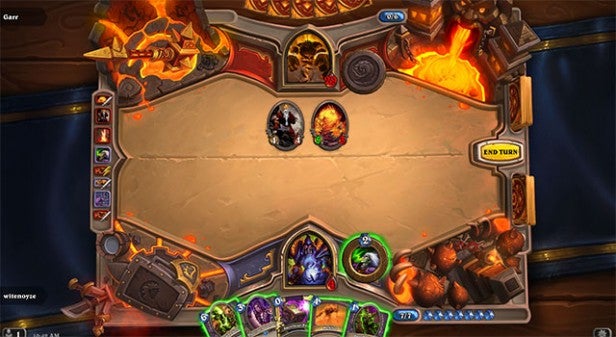
This is s a trick that the final boss in the Molten Core, Majordomo Executus, plays to great advantage as your match against him enters the final furlong (if, indeed, you manage to get that far). As his health points tick down, Molten Giants start landing on the board at a rate of knots. It’s worth stacking minions and maintaining board control until you have the attacks and spells in place to deliver a 10+ killing blow. The reason for this is because once you squelch Executus, the match isn’t over; his boss Ragnaros the Firelord pitches up with eight health and eight armour and any minion that Executus has managed to summon is now under his control.
So if you haven’t managed expectations up until this point, you’re pretty much dead.
See also: Xbox One vs Xbox 360
Once again, the key here is board control. If you can keep minions abundant and alive (which is harder than it sounds), then by the time Ragnaros pitches up you should have enough in the tank to defeat him. Remember, though, that board control, rather than dishing out damage to the boss is the most important tactic here. Otherwise, by the time Ragnaros pitches up, he’ll have everything he needs to turn you into paint in one turn.
The Challenge modes are far harder, if a little less interesting than they were in the initial level. You’re pitted against Garr with a Warrior Custom Deck and Geddon with a Shaman Custom Deck. The former stacks your deck with damage boosts and minions who grow stronger when they’re damaged for the most part – although don’t get the impression this makes the challenge a cakewalk – and the latter gifts the player with cards that mix power with overload – so you need to keep an eye on exactly how much manna you’re using at all times and make sure you don’t stymie yourself.
See also: PS4 vs PS3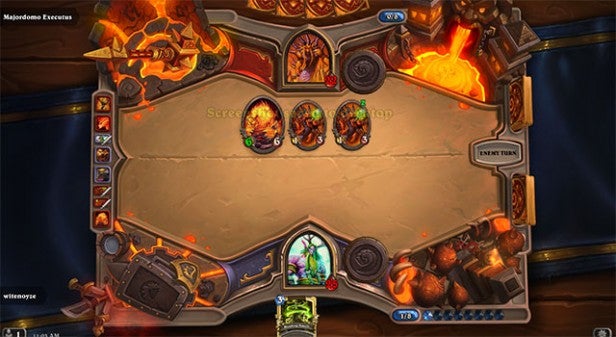
Hearthstone: Blackrock Mountain review diary – Week 1
Blackrock Mountain is the second adventure for Hearthstone’s Solo Play mode – coming on the heels of Curse of Naxxramas – and like its predecessor it’s split into five wings that become steadily more taxing as the play encounters them. Also, each wing costs £4.99 to open (or 700 in-game gold), or if you’d felt flush, you could’ve forked over £17.49 and pre-ordered the lot of them. That latter option, however, doesn’t mean you get to play all of them up front – you have to wait for each wing to become active over the next series of weeks, just like the rest of us.
In the meantime, players have three new boss fights – on both Normal and Heroic levels to choose from – and two Class Challenges (we’ll get to that in a minute). Like the Curse of Naxramas, Blackrock Mountain requires players to do a little deck rebuilding. They may be able to soar past one of the bosses with a pre-made deck, but the latter two will require a little tinkering on their part.
The first boss, Coren Direbrew, has a hero power that may prove something of a boon for players used to having to stave off attacks until they have the requisite manna to pull out their heavy hitters. Direbrew’s power – the aptly-named ‘Pile On!’ – yanks a random minion from both his and the player’s deck onto the battlefield whenever he activates it. And since it requires sod all manna for him to do it, this means every single turn.
This can provide the player with an edge if they’ve stacked their deck with nose-bleedingly expensive and tough minions, but anyone who’s used to relying on battle-cry abilities should have a re-think because Pile On! negates that power when the minion with it is summoned. It’s useful mixing minions with Taunt with those that have powerful attacks for this bout.
See also: Best iPad Games 2015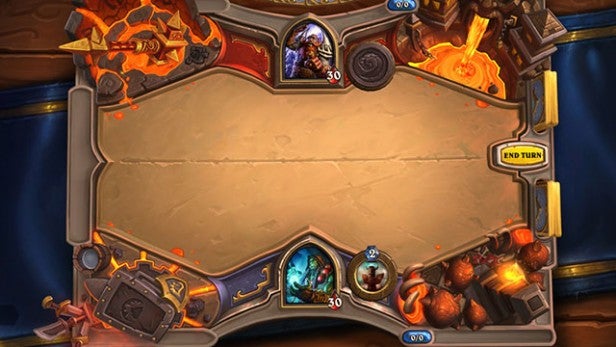
As has been said, if hard, expensive and heavy is usually the way you roll, Direbrew is a mere appetiser for what’s to follow. Direbrew’s deck is a mixture of annoying low-cost characters and high-level bruisers, but he’s got nothing on the boss following him: High Justice Grimstone, keeper of the grove. His power is pretty annoying to begin with: ‘Jeering Crowd’ (which costs him just one manna per use) summons a minion with one health, one attack and a taunt. They’re essentially cannon-fodder, but if you don’t get rid of them promptly, they have the potential to stack up at an alarming rate. This is made all the more vexing by the fact that Grimstone’s deck seems to consist almost entirely of Legendary Cards. Everyone from Feugen, to Nat Pagle, to Thalnos, to Lorewalker Cho, to Tinkmaster Overspark is likely to pitch up in the early stages of the game. You probably won’t last to see what the latter cards look like.
In a way, Grimstone’s deck is something of a tutorial as players are likely to take note of many of the Legendary Cards’ abilities – which range from the annoying to the positively lethal. For our money it’s worth stacking your deck with splash damage cards, taunts and any minions that can silence others, since the Legendary minions usually arrive with a some power – be it an ability or a death rattle. You can’t really do much about the battle cry abilities here and praying won’t help you. Believe us, we tried.
See also: Best Android Games 2015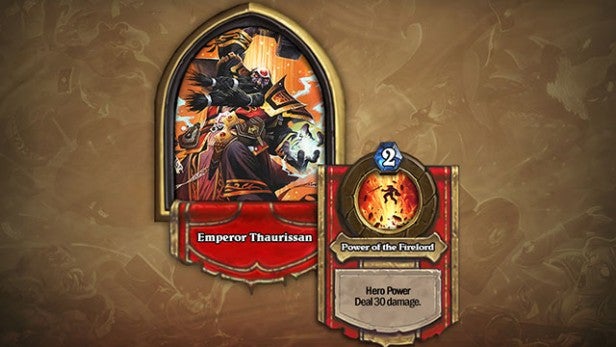
The final boss in this trio is by far the most interesting and the most irritating, too. The reason for this is that success involves keeping one of its minions alive throughout the entire fight. Emperor Thaurissan begins each match with his wife Moira Bronzebeard – a minion with one attack and three health – already in play. While she initially looks like a soft target, she is in fact a pain in the proverbial, because the player attacks her at their peril. If she dies during the match, her death allows Thaurissan to activate his hero power – which he can’t while she’s alive – which allows him to deliver a crushing 30 points of damage to his opponent.
Yes, you read that correctly. If you kill his wife, Thaurissan can wipe you out with one shot. Since she only attacks minions with taunts and the player, it’s worth stripping your deck of them. You also can’t play cards with massive splash damage. Or cards that have a power that deal damage to other minions upon their arrival or demise. In fact, it’s worth stacking your deck with spells that double a minion’s health and then playing them on Bronzebeard – especially if you tackle this boss on Heroic difficulty, since her health and attack scores are reversed.
See also: Best iPhone Games 2015
Naturally there are rewards for defeating the bosses in the form of new cards and you can pick up a new card-back for taking out the three of them on Heroic difficulty, demonstrating your prowess to all new opponents in Play Mode.
The Class Challenges are where things really get interesting. Players can tackle Direbrew with a Hunter Class or Grimstone with a Mage Class. The latter deals the player with a hand filled with unstable portals so they can pull through minions at a clip. The former stacks the player’s hand with Webspinners, which plonk a beast in the their hand when they die. After a couple of hands, they should be in possession of a group of beasts that look pretty impressive. That, however, is just the first round. On consecutive rounds, the board evens up a little as the Hunter’s deck is filled with some of the more interesting – and useful – beasts within the Hearthstone canon.
Verdict
Blackrock Mountain is a more than a simple diversion. It’s left-of-the-dial enough to warrant repeated plays and the new cards it spits out should tax players in the online mode significantly (unless they have them too). It’s a bit of a pain to have to wait to play the whole adventure, but then, didn’t you want something to look forward to next week?

